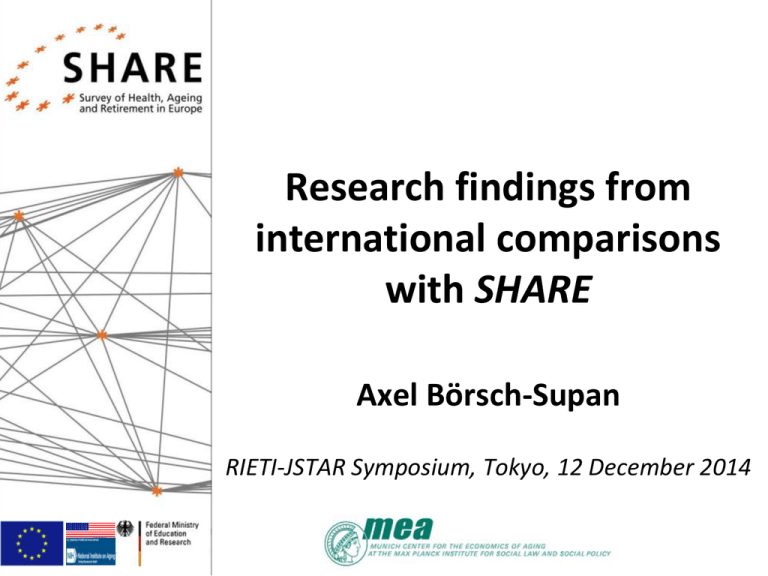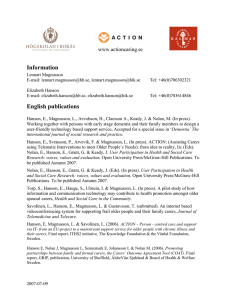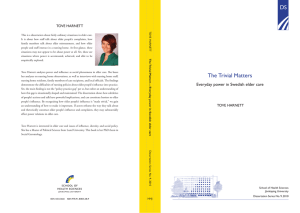Research findings from international comparisons SHARE
advertisement

Research findings from international comparisons with SHARE Axel Börsch-Supan RIETI-JSTAR Symposium, Tokyo, 12 December 2014 Outline 1. SHARE: Not only panel and X-disciplinary like JSTAR and HRS, but also X-national 2. Overview: Understand causes and effects of welfare state interventions impacting life at older ages: Overview of lessons learned 3. Three examples, refuting prejudices: --health around retirement --retirement effects on health --intergenerational cohesion of aging societies 2 EU Laboratory to evaluate social policies Wave 1 participation (2004): 11 countries: NL, DE, AT, DK, BE, FR, CH, SP, IT, GR, SE (+UK) SE Japan Korea China Waves 2 and 3 (2006 and 08): plus CZ, PL, IE, IL: 15 countries Wave 3 specialty: SHARELIFE histories Wave 4 participation (2010): plus EE, LU, HU, SI, PT: now 20 countries Wave 5 finished (2012/13) 83,000 resps, 230,000 interviews from 21 countries/1 region Mexico, Brazil India IL 3 Aims & principles Context Economic Income security, personal wealth, education dynamic • Aim: -Understand the ageing process in Europe (individuallongitudinal and societal level) Health -Basic research and fact-based policySocial development Living arrangements, Physical and mental, partnership, family, social networks, social support health care, disability, morbidity, mortality • Principle 1: Understand the interactions between health, labour force participation, and institutional conditions • Principle 2: Longitudinal – since ageing is a process, not a state • Principle 3: Use cross-national variation in policies, histories, cultures to understand causes and effects of welfare state interventions Methodology Representative samples of individuals age 50+ with spouse Face-to-face interviews by trained interviewers Broad range of questions, measurements and tests: Health: subjective-objective (self-report, ADL/IADL, conditions, physical performance, biomarkers incl. dried blood), physicalmental (cognition, MMSE, CES-D, Euro-D), health behaviors, health utilization and insurance coverage Socio-economic status: labor force participation, retirement, income (amount and sources), wealth, consumption, pension claims, expectations, well-being Social participation: activities (volunteering), family and social networks (size and intensity), help (time, money) 5 Main design challenge Distinguish methodological effects Ex ante / ex post harmonization from genuine policy effects: Different institutions and methods Different languages Different interpretations 6 Cross national organisation 5 main nodes more than 22 scientific partner institutions & ~160 scientists 23 survey agencies & about 2000 interviewers 7 Cross national comparability Ex ante harmonization: Internet based translation tool Ex ante harmonisation: Survey instrument to conduct Computer Assisted Personal Interviews (CAPI) Ex post harmonization: Country & wave specifics online overview 8 Cross national comparability Objective measurement Subjective self-assessment Source: Jürges, 2006 9 Outline 1. SHARE: Not only panel and X-disciplinary like JSTAR and HRS, but also X-national 2. Overview: Understand causes and effects of welfare state interventions impacting life at older ages: Overview of lessons learned 3. Three examples: (refuting prejudices) --health around retirement --intergenerational cohesion of aging societies --retirement effects on health 10 Selected new publications 2013 Health & Health Care Paccagnella, O., V. Rebba and G. Weber. Voluntary private health care insurance among the over fifties in Europe: A comparative analysis of SHARE data. Health Economics. Schröder, M. Jobless now, sick later? Investigating the long-term consequences of involuntary job loss on health. Advances in Life Course Research. Life Course Deindl. C. The influence of living conditions in early life on satisfaction in old age. Advances in Life Course Research. Schaan, B. Widowhood and depression among older Europeans - the role of gender, caregiving, marital quality, and regional context. The Journals of Gerontology Series B: Psychological Sciences and Social Sciences. 11 Selected new publications 2013 Retirement Reinhardt, J.D., M. Wahrendorf and J. Siegrist. Socioeconomic position, psychosocial work environment and disability in an ageing workforce. Occupational and Environmental Medicine. Brugiavini, A., G. Pasini and E. Trevisan. The direct impact of maternity benefits on leave taking: Evidence from complete fertility histories. Advances in Life Course Research. Börsch-Supan, A., and M. Schuth, Early retirement, mental health and social networks, In: David A. Wise (ed.), Discoveries in the Economics of Aging, University of Chicago Press. Socio-Economics Chen, M.K. The effect of language on economic behavior: Evidence from savings rates, health behaviors, and retirement assets. American Economic Review. 12 Selected new publications 2013 Family & Social Networks Lyberaki, A., Tinios, P., Mimis, A. and Georgiadis, T. Mapping population aging in Europe: how are needs met by different family structures?. Journal of Maps. Reinhold, S., T. Kneip and G. Bauer. The long run consequences of unilateral divorce laws on children — evidence from SHARELIFE. Journal of Population Economics. Brandt, M. and C. Deindl. Intergenerational transfers to adult children in Europe: Do social policies matter? Journal of Marriage and Family. 13 Outline 1. SHARE: Not only panel and X-disciplinary like JSTAR and HRS, but also X-national 2. Overview: Understand causes and effects of welfare state interventions impacting life at older ages: Overview of lessons learned 3. Three examples, refuting prejudices: -- health around retirement -- retirement effects on health -- intergenerational cohesion of aging societies14 Evidenz zum Gesundheitszustand älterer M enschen: Altersgradient Health at age 60-69 in Europe 90 Self rated: 80 60 percent Selbsteinschätzung excellent, very gut, sehr gut oder ausgezeichnet [in good and good Prozent] 50 Functional: 70 percent with no Keine Funktionseinschränkung [in ADLProzent] limitation 40 Objective: 30 Grip strength Greifkraft [in kg] kg with std in orange Schwankungsdeviation breite 20 10 0 60 61 62 © MEA @ MPISOC 63 64 65 66 67 68 69 15 90% more prevalent among less educated men 60% more prevalent among less educated women 16 PERCENT VERY HEALTHY (objective functional measure) © MEA @ MPISOC Source: SHARE 2005 17 (Rohwedder and Willis 2010 with SHARE data) 18 11 Early 10 Normal 多項式 (Early) Cognition score 9 多項式 (Normal) 8 7 Cognition by age and retirement pathway 6 5 60 65 Source: Börsch-Supan & Schuth 2014 70 75 80 85 Age 19 1 Early 0.9 Number of friends and colleagues Normal 多項式 (Early) 0.8 多項式 (Normal) 0.7 0.6 Social inclusion by age and retirement pathway 0.5 0.4 60 65 Source: Börsch-Supan & Schuth 2014 70 75 80 85 Age 20 1. Cognition -> Retirement: Those with low cognition tend to retire earlier 2. Retirement -> Cognition: Those who retire earlier loose their cognition faster 3. Cognition -> Social networks: Smart and succesful individuals have more friends 4. Social networks -> Cognition: Those who retire earlier loose their friends faster 21 The value of international variation Instruments for years since early retirement: Time since eligible for early retirement Time since eligible for normal retirement Causal effect: Ex ploit variation of early retirem ent rules in SHARE countries Rohwedder/Willis 2010 JEconPersp 22 The value of regional variation Instruments for number of non-family members in the social network: “social capital” at the regional level (NUTS-1) 1. 2. Trust in other people among the population 50+ separated by country and gender Higher level of (aggregated) trust -> more social contacts Population density at national level Higher population density -> more non-family social contacts? Higher population densities create public distrust and increases need for privacy (Brueckner & Largey 2006, Collier 1998) 23 Second stage: RET & SN -> COG Table 10: Second stage IV-estimation: The effect of (early) retirement and social networks on cognition ---------------------------------------------------------------------------(1) (2) (3) (4) cogn cogn cogn cogn ---------------------------------------------------------------------------ERdist -0.218*** -0.149 -0.180* -0.185** (0.027) (0.099) (0.104) (0.088) NRdist -0.138*** (0.012) -0.106 (0.065) -0.136** (0.064) -0.120* (0.063) sn_fc 1.919*** (0.473) 1.177** (0.507) 1.067** (0.512) 1.037** (0.516) Demographics Health Country/age effects No No No yes no no yes yes no yes yes yes ---------------------------------------------------------------------------N 19944 19944 18531 18531 F 185.946 272.813 228.672 155.855 Fp 0.000 0.000 0.000 0.000 ---------------------------------------------------------------------------Standard errors in parentheses, * p<0.10, ** p<0.05, *** p<0.01 Source: Börsch-Supan & Schuth 2014 24 13 15 16 19 21 22 29 30 31 33 37 2 2.1 2.5 2.9 3.5 3.8 3.9 4.3 4.4 6.7 8.7 % of dyads SHARE 2004, n=7.825/40.073 dyads. weekly hours Source: Brandt/Deindl 2013 25 40 NL 30 40 DK SE BE CH DEFR 20 IT GR 10 20 10 r=0.70*[0.76**] 0 1 2 3 4 5 6 7 8 9 10 Sozialausgaben in 1000 USD pro Kopf Social expenditure (1000 USD/cap) 40 DE 30 NL CH 20 GR 10 IT BE SE DK FR AU 2 4 6 8 10 12 Familienausgaben in 100 USD pro Kopf Family expenditure (´100 USD/cap) NL CH FR ES r=0.92**[0.90**] 0 0 state 5 10 15 20 Anteil Beschäftigter in sozialen Dienstleistungen Social services (employees per cent) 40 NL DE CH 20 IT GR 10 r=0.72*[0.80**] 0 AU 30 ES 0 GR IT AU ES 0 DE BE 30 DK SE BE SE DK FR AU ES r=0.69*[0.75**] 0 0 state 1 2 3 4 5 6 7 Familienausgaben an Gesamtstaatsausgaben Family expenditure /state expenditure Source: Brandt/Deindl 2013 Hilfebeziehungen in Prozent help dyads family Hilfebeziehungen in Prozent per cent Help to parents and social policies 26 Map 4: Conflicts with children in European regions Figure 1: Old age dependency ratio in European regions (Börsch-Supan, Heller, Reil-Held 2012) More in „old“ regions? 27 Map 5: Conflicts with parents in European regions Figure 1: Old age dependency ratio in European regions (Börsch-Supan, Heller, Reil-Held 2012) More in „old“ regions? 28 reverse yes reverse reverse reverse reverse Non-family relations: 7. Having at least one friend who is younger than 30 (all respondents) 8. Having at least one friend who is younger than 30 (older than 64) 9. Having at least one friend who is older than 70 (all respondents) 10. Having at least one friend who is older than 70 (younger than 30) 11. Meeting socially at least once a week (all respondents) 12. Meeting socially at least once a week (younger than 30) 13. Meeting socially at least once a week (older than 64) 14. Felt age discrimination (all respondents) 15. Felt age discrimination (younger than 30) 16. Felt age discrimination (older than 64) yes yes reverse reverse yes yes yes reverse reverse yes (Börsch-Supan, Heller, Reil-Held 2012) Family relations: 1. Financial transfer provided to children 2. Financial transfer received from children 3. Conflict with children and grandchildren 4. Conflict with parents 5. Trust to children and grandchildren 6. Trust to family members over 70 Values and political preferences: 17. Higher taxes and spending more on social services? (all respondents) reverse 18. Higher taxes and spending more on social services? (younger than 30) reverse 19. Higher taxes and spending more on social services? (older than 64) reverse 20. Family or state responsible for financial support for older persons yes 21. Family or state responsible for help with household chores for older persons reverse 22. Family or state responsible for personal care for older persons reverse 29 X-national and X-disciplinary panel data are an enormous help to better understand active aging SHARE: Intra-European variation in policies, histories and habits helps to identify causal pathways and to refute prejudices: • Health is good at old age, healthcare a worthwhile investment • Retirement: not only bliss: watch out for negative side effects • Societal cohesion: upcoming intergenerational conflict a myth 30




